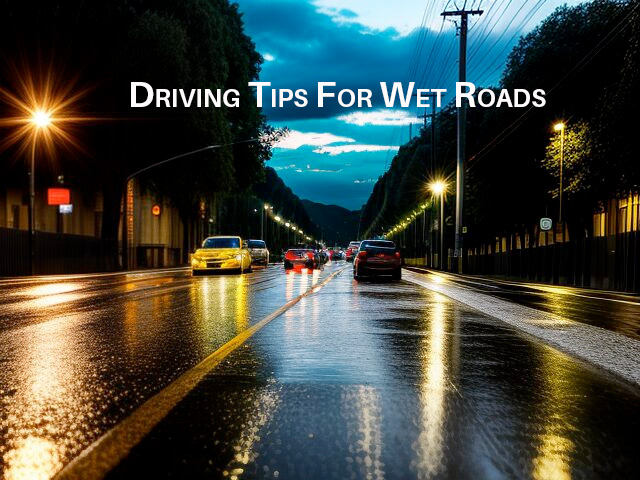Driving Tips For Wet Roads
From the General Tires website
Driving in the rain can be dangerous; in fact thousands of car accidents each year are caused by wet driving conditions. It doesn’t have to be this way though. We have a few simple tips to help you navigate those wet roads.
Routinely Check Your Tires – It’s a good idea to always check your tires before you hit the road. To ensure your tires are working at their best, make sure you do the following routine maintenance:
- Keep your tires properly inflated. The correct air pressure for your tires is specified by the vehicle manufacturer and can be found on the vehicle door frame, door post, or owner’s manual. The number listed on the side of the tire is not the recommended air pressure for your tire — it is the maximum air pressure for the tire. You should check your tire’s air pressure at least once a month. It takes five minutes and will save you money and headaches down the road.
- Check the tire’s tread depth. Tires should have 2/32nds of an inch tread depth in order to perform in the way for which they were designed. Proper tread depth will help prevent skids and hydroplaning.
- Have your tires rotated at least every 6,000 – 7,000 miles. This will aid in detecting alignment problems and help prevent irregular wear.
Slow Down – As rain falls, it mixes with grime and oil on the road creating slick conditions – perfect for skids. The best way to avoid skidding is to slow down. Driving at a slower pace allows more of the tire’s tread to make contact with the road, which leads to better traction.
Recover From a Skid – Skids can even happen to the most cautious drivers. If your car does skid, remember not to slam on the brakes, and do not pump the brakes if you have an anti-lock braking system (ABS). Instead apply pressure to the brakes in a firm manner and steer the car in the direction of the skid.
Keep a Safe Distance – It takes about three times longer to brake on wet roads than it does on dry roads. Since more distance is required to brake, it is important not to tailgate. Keep more than two car lengths between you and the vehicle in front of you.
Recover from Hydroplaning – When it rains, water creates a barrier between the road and your tires. The liquid film that forms can cause you to lose traction and glide or hydroplane across the water’s surface. If this happens, do not brake. It is better to take your foot off the gas, hold the steering wheel in place, and lightly apply the brakes. If you have a manual transmission, push in the clutch and let the car slow down on its own.
Take Advantage of Tire Technologies – General Tire incorporates a variety of technologies to help drivers monitor tire wear and navigate wet roads. Look for technologies such as:
- Replacement Tire Monitor – The RTM (Replacement Tire Monitor) provides the user with a warning when the tire is worn and has to be replaced. The inscription “Replacement Tire Monitor” shows three times on the circumferential rib of the new tire. Just before the tread reaches the minimum tread depth indicated by the TWI (Tread Wear Indicator bars), the inscription will change to “Replace Tire”
- Visual Alignment Indicator – The VAI (Visual Alignment Indicator) allows the user to check wheel misalignment to avoid irregular wear of the tires. The VAI is represented three times in the circumference of the tire by two additional sipes (1.6mm tread depth) on the opposite shoulder blocks of the tire. If the sipes of the VAI wear off differently (one side more than the other for example), it means that there is potential misalignment of the wheels.
Visit your local General Tire dealer, ADVANCE TREADS for more information.
For more information contact Advance Treads at 856-696-5004



